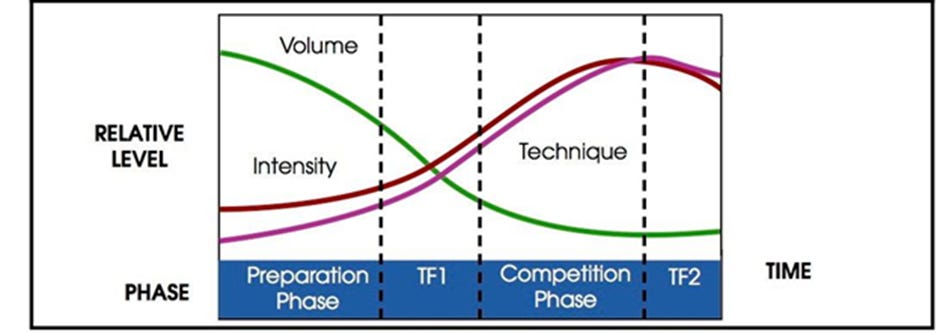Patients Playbook | Fuel, Train, Recover: Keeping Hybrid/Hyrox Athletes in the Game
This is a no-paywall blog post with insights I believe are valuable. If you find it useful, subscribe to my Substack for more in-depth content, exclusive case studies, and clinical insights.
Your support helps me continue sharing everything I’ve learned in the clinic with the world
☕ Prefer a one-off thank you? Buy Me a Coffee.
This post is a guide only and should not be taken as medical advice. It does not replace assessment and recommendations from a registered and regulated healthcare professional.
Summary
What is a Hybrid Athlete?
Hybrid athletes (or Hyrox athletes) train across multiple disciplines, such as endurance (running, cycling) and strength (weightlifting, CrossFit). While this versatile approach is trending on social media for its extraordinary appeal, it requires careful planning to balance competing demands and reduce injury risk.Fuel Your Body
Proper nutrition is essential. Low Energy Availability (LEA), common in athletes trying to maintain lean physiques, can lead to hormonal imbalances, weaker bones, and reduced performance. Both men and women are at risk, highlighting the importance of personalised dietary advice.Train Gradually and Avoid Spikes
Sudden jumps in training volume or intensity increase the risk of overuse injuries. Structured periodisation models, like “3 Up/1 Down,” help build fitness while balancing effort and recovery. Consistency and long-term planning are key to success.Recovery: Focus on the Basics First
Recovery is critical for staying injury-free. Start with good sleep, hydration, and nutrition before turning to tools like Heart Rate Variability (HRV) tracking. HRV can provide insights into recovery but should complement — not replace — the fundamentals.Seek Expert Guidance
To prevent injuries and optimise training, consult qualified professionals like Sports Physiotherapists, Strength and Conditioning Coaches, or Dietitians. Avoid relying on social media influencers for advice, as expertise lies in evidence-based, individualised strategies.
Earlier last year, if you asked me what a “Hybrid Athlete” was, I would have probably responded with:
“Is it a Tactical Athlete — an Army Special Force soldier who has to be fit enough to go on a 20km, 30kg pack march, but then go through short bursts of ‘Fire and Movement’ drills, and then carry someone out of the battlefield on a stretcher over obstacles?”
Or perhaps:
“It must be a multi-event track & field Athlete such as a Decathlete or Heptathlete who train hard to compete in a mix of throwing, running and jumping events.”
Yes… but no, but sort of.
The term “Hybrid Athlete” generally refers to anyone who trains across multiple disciplines, such as endurance (running, cycling) and strength training (weightlifting, CrossFit), often simultaneously. The term is often interchanged with ‘Hyrox’, short for Hybrid Rockstar.
Engagement on Social Media is driven by intrigue in the extra-ordinary: ripped bodies, massive workouts, extreme feats of endurance and strength. The ‘Hybrid Athlete’ is therefore trending on social media due to its appeal of combining contrasting athletic capabilities.
Each individual Sport or Exercise usually has its own profile of injuries that we’d expect. Gym junkies can get the odd sore shoulder with bench press or painful and tight hips with depth in squats. Runners can get the lower limb stress fractures or the ‘Runners Knee’ (patellofemoral pain). Influencers get jaw pain from that constant pouty-kissy-duck face.
So what does a Hybrid Athlete needs to consider to reduce injury risk and improve their training?
Fuelling the Beast — Are They Eating Enough?
Athletes must balance their energy intake with training demands to stay healthy and perform at their best. RED-S (Relative Energy Deficiency in Sport) highlights the impact of Low Energy Availability (LEA), which occurs when they’re not eating enough to meet their body’s needs (Energy Out > Energy In).
This can lead to problems like:
Hormonal Imbalances:
Women may experience irregular or missed periods due to low oestrogen and progesterone.
Men may face reduced testosterone levels, affecting strength and recovery.
2. Weaker Bones:
LEA weakens bones, increasing the risk of stress fractures — especially in sports that emphasize leanness.
3. Other Health Issues:
Slower metabolism, low iron levels, a weaker immune system, and growth delays in younger athletes.
Heart and digestion problems, including low blood pressure and constipation.
4. Performance Drops:
Poor recovery, more frequent injuries, and slower speeds due to inadequate fuel.
The myth of “leaner is better” can backfire, reducing power and endurance.
LEA isn’t just a female issue — male athletes in high-demand or weight-class sports face similar risks, including hormonal changes (reduced testosterone) and reduced performance.
The Risk of Social Media Pressures negatively impacting Fuelling
Low Energy Availability might also be impacted by negative Eating Behaviours. Social media platforms (particularly Instagram) often amplify pressures to achieve unrealistic body ideals, leading to harmful eating behaviours. These behaviours can range from clinical eating disorders to disordered eating patterns, both of which can negatively impact health and performance:
Eating Disorders:
Diagnosed mental illnesses involving abnormal eating behaviours, such as severe food restriction, bingeing, purging (e.g., vomiting or laxative use), or obsessive preoccupation with body image and weight.
2. Disordered Eating Behaviours:
Irregular or harmful eating habits that don’t meet clinical criteria for an eating disorder, including restrictive eating, compulsive eating, excessive exercise to “burn off” food, or inflexible food routines.
Social media often glorifies lean physiques and extreme workouts, creating a toxic cycle of comparison and pressure. For hybrid athletes, maintaining a balanced and healthy relationship with food and body image is critical for physical and mental wellbeing. Seeking support from professionals like sports dietitians and psychologists can help athletes navigate these challenges effectively.
The Takeaway on Fuelling:
For all Athletes with a high weekly training load eating enough is essential for health, recovery, and achieving their goals. A Sports Dietitian consult can be extremely useful to a Hybrid Athlete to ensure they are meeting their nutritional needs. For helpful resources, visit:
Sports Dietitians Australia, they have many factsheets including ‘Nutritional challenges of the female endurance athlete’ .
If Athletes are having significant and persistent long-term injuries such as stress fractures which might be related to Low Energy Availability, they should seek the guidance of a Sports and Exercise Medicine Physician (GP referral required) or a SEM Physician Registrar (GP referral not required)– they can organise bloods and other investigations that can help identify the individual medical needs of the Athlete.
Gradual Training Increases: Avoiding Spikes and Staying Consistent
It’s not the load; it’s how you got there.
The Athlete should be gradually building their training over time to greatly reduce the risk of overuse injuries. Big jumps in training — like going from 8 hours one week to 15 for the next two weeks put sub-optimal stresses on the body. This is why periodisation, or planning training load over time, is so important.

Tracking load is much easier when an Athlete is specialising in one field (e.g., runners tracking weekly distance), it become tricky when the Hybrid Athlete has to track all training across multiple disciplines, so keeping things simple is the way to go.
Here’s the goal: gradually build up weekly training load (load = intensity x time) over months (high ‘Chronic Load’), whilst avoiding big jumps in training hours/week (spikes in ‘Acute Load’). It is following these Acute spikes where overuse injuries often occur, especially after a prolonged spike (e.g., 2–3 weeks) without a recovery period.

Handy Training Models
Those who have been in the S&C/Gym game for a while will know about periodisation in strength training with the aim of ‘progressive overload’. Whether it’s planning time blocks to focus on strength, hypertrophy or power, or it’s more broadly looking at resistance training volume vs intensity over time in order to peak at the right time for performance in a comp.
Long-term planning of the training (looking ahead 3–6 months) can really assist in knocking back the injury rate of the Athlete. However, here’s a couple of simple and general training cycles that Athletes can utilise when planning out their training over time.
3 Up/1 Down: Three weeks of high load followed by one recovery week of low training load.
Low-Medium-Low-High: Alternating training load weekly to manage fatigue and recovery.
These aren’t recipes, they don’t have to be spot on every week, they just need to establish a training pattern that the body gets used to. The load weeks can be altered to meet specific athletic events such as a half-marathon, by slipping that in the high week and having the low weeks beforehand and after.


To calculate training load, for each session of training multiply session minutes x session intensity (#/10), log it and track these over time. The Athlete can then modify session minutes or session intensity to help stay in the target for each week.
Don’t Skip Training Completely
If an Athlete is going on holiday, they should try to fit in some activity. They can move their scheduled ‘low week’ or ‘low month’ up earlier. Completely stopping training can cause detraining — lowering ‘chronic load’, and when they return, they’ll be at a higher risk of injury due to a sudden spike in load.
The key is consistency — training smarter, not harder, and balancing effort with recovery for long-term success.
Follow Dr Tim Gabbett’s work for the latest on planning training loads for injury prevention.
Balancing Hybrid Training Demands with Skill Acquisition
Mastering new skills while maintaining fitness is a critical part of hybrid training. Good technique isn’t just about optimising performance — it’s also key to avoiding injuries. It can be tricky balancing the high volume of training required to master new skills within an existing training program.
Learning New Skills Safely
For Runners Transitioning to Strength Training: Marathon runners entering the gym for the first time should start slow and seek guidance from a Strength & Conditioning Coach, an S&C qualified Sports Physiotherapist or Exercise Physiologist. Proper lifting technique is essential to reduce injuries over the training year.
For Lifters Transitioning to Running: Athletes accustomed to weight training but new to running should consult a running coach or a Physiotherapist/Exercise Physiologist — or follow one of the many popular gradual running programs. A structured plan, the right footwear, and a gradual progression are critical to reducing injury risk. A Sports Podiatrist, or even a specialist Running Shop (usually one in every big town), can be very useful at finding the right shoe for the new distance runner.
Balancing the Demands of Hybrid Training
A hybrid athlete must embrace balance. A sprinter will likely outperform a hybrid athlete in a 100m dash, and a specialised thrower will excel in javelin. Being a hybrid athlete isn’t about being the best at one thing; it’s about being good at many things.
The hybrid athlete should focus on training that reflects this versatility while avoiding burnout or injury. Recognising the value of variety and balance in their approach allows them to reap the benefits of hybrid training while staying healthy and consistent.
Recovery and Technology Integration
Recovery is just as important as training — it’s the time when the body adapts, grows stronger, and prepares for the next session.
Take the pause your body needs, or it will force one on you.
Alongside consistent, high-quality nutrition, hydration, and sleep; maintaining a regular sleep/wake routine is the cornerstone of effective recovery.
These fundamentals should be mastered before introducing advanced tools like compression pants or technology.


Monitoring recovery enables athletes to optimise performance, avoid overtraining, and recognise when the body needs rest.
Tools such as smartwatches can assist by providing insights through features like manufacturers’ algorithms (e.g., Garmin’s Body Battery or Fitbit’s Readiness Score) and more precise metrics like Heart Rate Variability (HRV) tracking.
What is HRV?
HRV measures the small variations in time between heartbeats, offering a window into how well the body manages stress and recovery. A higher HRV generally indicates readiness to train, while a lower HRV may signal stress, fatigue, or the need for more rest. Devices like smartwatches or chest strap monitors make HRV tracking accessible and practical for adjusting training loads.
But even the Athlete on the smallest budget can simply keep a log of Sleep Quality (subjective score out of 10), Sleep Quantity (hrs) (most phones track sleep now) and general mood (subjective score out of 10) and track it over time and monitor for significant changes.
Overtraining vs. Under-Recovery
Sometimes when there is an unexplained drop in performance the issue isn’t overtraining, but under-recovery — a failure to meet the body’s needs for rest, sleep, and proper nutrition. Recovery doesn’t mean doing less; it means doing the right things to allow the body to repair and adapt. However, recovery doesn’t mean complete rest — we use the term ‘relative rest’ which simply means ‘doing less than usual’ — usually 40–70%/week as a guide.
Recognising the Signs of Overtraining or Under-Recovery
Physical Signs: Persistent tightness, stiffness, or soreness that doesn’t align with training intensity.
Sleep Issues: Difficulty falling asleep or staying asleep, indicating inadequate recovery.
Performance Drops: Declining strength, speed, or coordination despite continued effort.
Practical Tips for Better Recovery
Master the Basics: Prioritise sleep and balanced nutrition as the foundation of recovery.
Use Technology: HRV tracking and smartwatch features like sleep and activity monitoring provide valuable insights into recovery status.
Listen to the Body: Adjust training or rest routines if the body shows signs of fatigue or stress.
Incorporate Active Recovery: Low-intensity activities like walking, swimming, cycling, or mobility routines can aid recovery without overloading the body.
By combining these fundamentals with insights from recovery tools, athletes can fine-tune their approach to training and ensure long-term progress while minimising the risk of burnout and injury — and maybe also saving time and money by skipping unnecessary pseudoscientific gadgets and treatments.

When Things Break Down, See the Experts
When Athletes need help recovering from an injury, improving performance, or fuelling their body, it’s important to seek advice from registered and regulated professionals. These experts are trained to provide the most valid and reliable guidance and are focused on helping the Patient/Client— not just gaining followers or making money on social media.
Some of the best professionals aren’t active on social media because they’re busy working with clients or simply don’t prioritise an online presence. If Athletes want expert advice, turn to qualified specialists, including:
Sports or Musculoskeletal Physiotherapists
Sports and Exercise Medicine Physicians
Exercise Physiologists
Strength and Conditioning Coaches
Accredited Practising Dietitians or Sports Dietitians
Podiatrists
Sports Psychologists
Thanks to COVID, many high quality professionals have also embraced Telehealth and can offer distance consults, including across the World.
Investing in real expertise ensures the Athlete get the personalised care and evidence-based strategies they need to stay healthy, recover properly, and perform at their best.
Conclusion
Hybrid athletes combine the best of endurance and strength disciplines, making them highly versatile but also placing unique demands on their bodies. To succeed and minimise injury risk, it’s essential to prioritise nutrition, gradual training progression, and effective recovery strategies. Master the basics — consistent sleep, proper hydration, and balanced nutrition — before exploring advanced tools like HRV tracking.
By adopting a structured, evidence-based approach and seeking guidance from qualified professionals, hybrid athletes can optimise performance, stay healthy, and enjoy the benefits of their unique training style. Remember, it’s not just about doing more — it’s about doing it smarter.
Did you find this valuable? If so, even a small contribution helps me keep content like this going.
This is high-value information that normally costs hundreds of dollars in a clinic—here, you get it for free.
☕ Buy Me a Coffee to say thanks, or become a paid subscriber and get subscriber-perks such as asking me about anything Musculoskeletal pain and injury in the Substack chat.
Links:
More helpful Factsheets from one of Canberra’s Sports Dietitians Erica Stephens https://www.sportrition.com.au/resources/factsheets
Dr Tim Gabbett — https://gabbettperformance.com.au/blog/
Tailor your Nick Ilic | Physio Clinician subscription:
You can customise which topics you receive updates for by selecting 'Manage Subscription' in your Substack options (in your browser), or by clicking 'unsubscribe' at the bottom of any email—don’t worry, it won’t unsubscribe you immediately! You'll then be able to choose your preferred sections:
✅ Patient Playbook
✅ Clinician’s Corner
✅ Research Reviews
✅ Clinician’s Compass
Choose what suits you best—I promise I won’t take it personally!


























